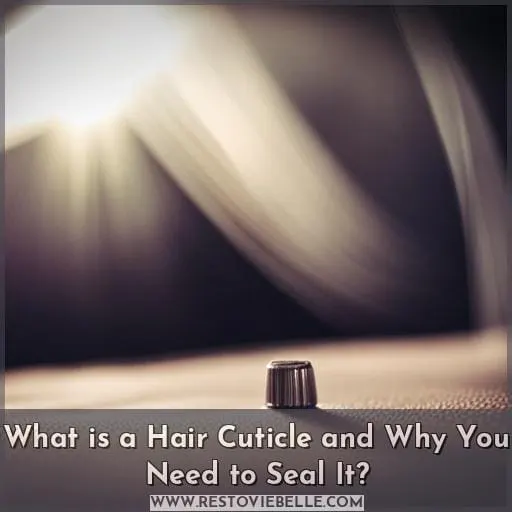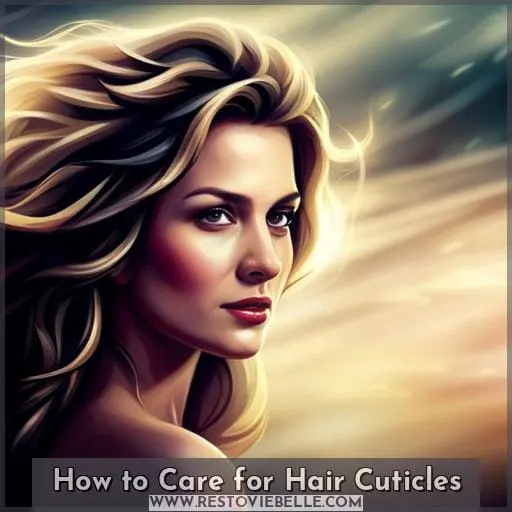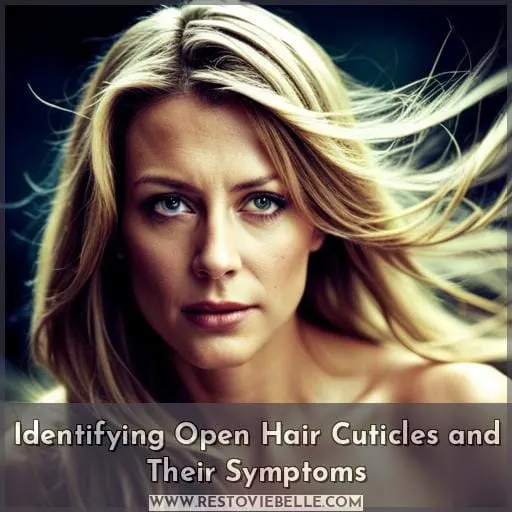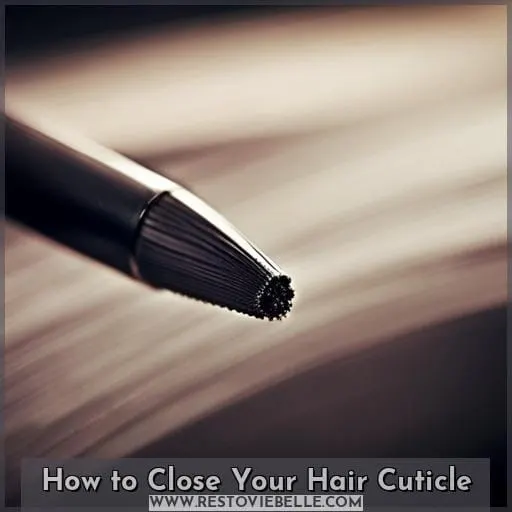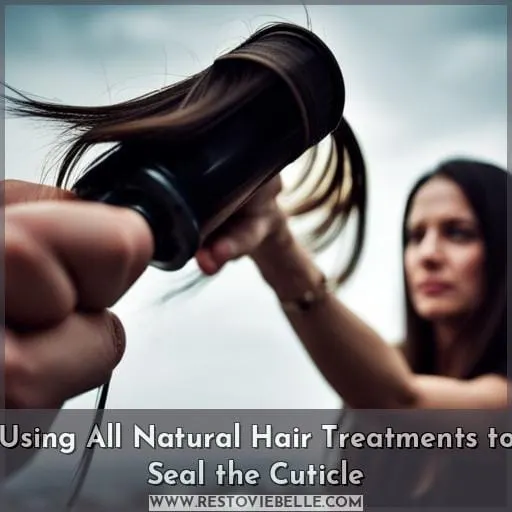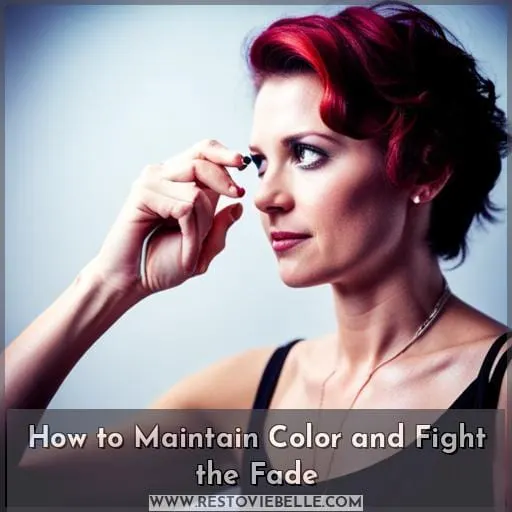This site is supported by our readers. We may earn a commission, at no cost to you, if you purchase through links.
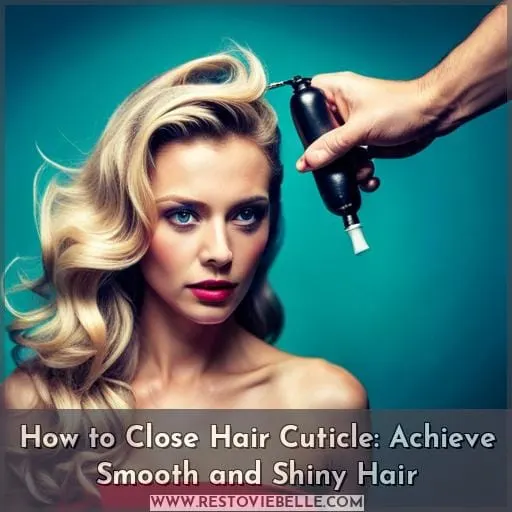 Discover the secrets to achieving smooth and shiny hair by learning how to close your hair cuticle. By sealing the cuticle, you can prevent damage and create a healthy and vibrant look for your strands.
Discover the secrets to achieving smooth and shiny hair by learning how to close your hair cuticle. By sealing the cuticle, you can prevent damage and create a healthy and vibrant look for your strands.
In this article, we will guide you through simple steps that will help you care for your hair cuticles effectively. From using pH balancing products to avoiding heat damage, we have all the tips you need to achieve beautiful locks that radiate confidence and style.
Table Of Contents
- Key Takeaways
- What is a Hair Cuticle and Why You Need to Seal It?
- Understanding the Different Parts of the Hair
- How to Care for Hair Cuticles
- What Can Cause Hair Cuticles to Open?
- Identifying Open Hair Cuticles and Their Symptoms
- How to Close Your Hair Cuticle
- Using All Natural Hair Treatments to Seal the Cuticle
- How to Maintain Color and Fight the Fade
- Frequently Asked Questions (FAQs)
- Can hair cuticles repair themselves naturally?
- Can using heat protectant products prevent cuticle damage?
- Are there any specific hair types that are more prone to open cuticles?
- Can using cold water alone effectively seal the hair cuticle?
- How long does it typically take for a damaged cuticle to heal and close?
- Conclusion
Key Takeaways
- Rinse hair with cold water after shampooing and conditioning.
- Use an apple cider vinegar treatment as a final rinse.
- Apply oil to moisturize and protect the cuticle.
- Avoid heat styling tools and harsh styling techniques.
What is a Hair Cuticle and Why You Need to Seal It?
To achieve smooth and shiny hair, it’s important to understand what a hair cuticle is and why you need to seal it.
The hair cuticle is the outermost layer of the hair shaft, consisting of overlapping keratin cells that resemble fish scales. Its main function is to protect the inner layers of the hair from damage caused by external factors such as heat, chemicals, and environmental elements.
A healthy cuticle ensures that your strands remain moisturized and strong while also providing shine. However, when the cuticle becomes damaged or open, it can lead to dryness, frizz, breakage,and reduced shine in yourhair.
Closingthehaircuticlesisessentialtorestoreandmaintainhealthyhair.PH balancingproductsarekeyinrepairingthecuticles.These pH-balancing products help bring back your strands’ natural acidity level (4.
To maintain optimum health foryour locks,it’scrucialto prioritize sealingyourhaircuticleroutinely
Understanding the Different Parts of the Hair
Now that you understand the importance of sealing the hair cuticle, let’s dive deeper into understanding the different parts of the hair.
The hair shaft is composed of three layers: the medulla, cortex, and cuticle. These layers work together to protect and nourish your strands.
The medulla, located at the center of your hair shaft, contains soft keratin cells that provide structure.
Surrounding it’s the cortex which gives your hair its color and strength through protein-rich fibers.
Finally, we’ve our outermost layer known as the cuticle – a thin protective barrier made up of overlapping cells resembling fish scales.
Understanding these components allows us to better comprehend how certain factors like pH levels can affect our overall strand health and appearance.
How to Care for Hair Cuticles
To care for your hair cuticles and achieve smooth and shiny hair, start by using a pH balancing shampoo to restore the natural acidity of your hair.
Follow up with an in-shower glossing treatment to seal the cuticle and add shine.
Finish off with a pH balancing conditioner to further protect your strands.
Step 1: Start With a PH Balancing Shampoo
To care for your hair cuticles and achieve smooth, shiny hair, start by using a pH balancing shampoo. This type of shampoo helps to restore the natural acidity of your hair, which is important for sealing the cuticle and preventing frizz.
After shampooing with a pH balancing shampoo, follow up with an in-shower glossing treatment two to three times a week.
Finish off by applying a pH balancing conditioner after both the glossing treatment and regular shampooing to further nourish and protect your hair cuticles from damage.
Step 2: Apply an In-Shower Glossing Treatment
Continue caring for your hair cuticles by taking the next step: applying an in-shower glossing treatment that will help seal and protect your hair.
Use the glossing treatment after shampooing, but before conditioning. Apply it two to three times a week for best results.
This treatment contains ingredients that smooth down the hair cuticle, leaving your locks looking shiny and frizz-free.
Be sure to follow the instructions on how to use it properly and avoid overuse as excessive treatments may lead to buildup or weigh down your hair.
Step 3: Apply a PH Balancing Conditioner
To further care for your hair cuticles, you should always apply a pH balancing conditioner after using an in-shower glossing treatment.
- Choose a pH balancing conditioner suitable for your hair type.
- Apply the conditioner evenly from root to tip.
- Massage it into your scalp and leave it on for a few minutes before rinsing.
- Enjoy the benefits of smoother, shinier hair with improved manageability.
Step 4: Protect Your Strands
Now, protect your strands by using a leave-in treatment and heat protectant.
Avoid harsh chemicals that can damage the hair cuticles and opt for gentle products instead.
Use a leave-in conditioner to provide extra moisture and nourishment to the hair while creating a protective barrier against external factors.
Additionally, avoid hot water when rinsing your hair as it can strip away natural oils and open up the cuticle.
Instead, finish with a cold water rinse to seal in moisture and promote smoother, shinier hair.
What Can Cause Hair Cuticles to Open?
Hot water, heat styling tools, chemical treatments, harsh brushing, UV rays, and drying hair too quickly can all cause the cuticles of your hair to open up.
These factors can strip away the natural oils from your hair and disrupt its pH balance.
Hot water can be particularly damaging as it opens up the cuticles and makes them more susceptible to damage.
Heat styling tools such as straighteners and curling irons also contribute to cuticle damage by exposing your hair to high temperatures.
Chemical treatments like bleaching or perming weaken the structure of the cuticle cells.
Harsh brushing techniques can roughen up the outer layer of your strands while UV rays from sunlight break down proteins in your hair shafts over time.
To maintain healthy-looking locks with sealed cuticles, it’s important to minimize exposure to these damaging elements whenever possible.
Identifying Open Hair Cuticles and Their Symptoms
To identify open hair cuticles and their symptoms, there are a few key factors to consider.
Common causes of open cuticles include:
- Hot water
- Heat styling tools
- Chemical treatments
- Harsh brushing
- UV rays
- Drying hair too quickly
Symptoms of open cuticles can manifest as:
- Dryness
- Frizzy hair
- Breakage-prone strands that easily tangle
By understanding these signs and causes of open cuticles you can take the necessary steps to close them for smoother and shinier hair.
Common causes of open cuticles
When your hair cuticles are open, it’s typically caused by various factors such as:
- Hot water
- Heat styling tools
- Chemical treatments
- Harsh brushing
- UV rays
These elements can strip away the natural oils and moisture from your hair, leaving the cuticles exposed and vulnerable to damage.
- Dryness
- Frizzy hair
- Breakage
- Easily tangled hair
It’s important to identify these symptoms so you can take steps to close the cuticle and achieve smoother and shinier hair.
Symptoms of open cuticles
If you frequently experience dry, frizzy hair that’s easily tangled and prone to breakage, these may be symptoms of open cuticles.
When the cuticle layer of your hair becomes damaged or lifted, moisture escapes from the cortex, leading to dryness and dullness. This also makes your hair more susceptible to environmental factors like humidity and heat damage.
Additionally, open cuticles can cause the outer layer of your hair shaft to become rough, resulting in frizz and tangles.
Methods to close cuticles
To close open hair cuticles and achieve a smooth and shiny appearance, you can try the following methods:
First, avoid using excessive heat on your hair.
Use a leave-in conditioner to provide moisture and protection.
Additionally, incorporate oil into your haircare routine to seal the cuticle and add shine.
Remember to choose products that are suitable for your specific hair type in order to effectively close the cuticles and maintain healthy-looking locks.
How to Close Your Hair Cuticle
To achieve smooth and shiny hair, there are several steps you can take to close your hair cuticle.
First, rinse your hair with cold water after shampooing and conditioning to help seal the cuticle.
Secondly, try using an apple cider vinegar treatment as a final rinse to restore pH balance and promote shine.
Additionally, applying oil to your hair can help moisturize and protect the cuticle from damage.
Lastly, avoiding heat styling tools and harsh styling techniques will prevent further damage to the already closed cuticles of your hair shafts.
Step 1: Rinse Hair With Cold Water
To begin closing your hair cuticle and achieve smoother, shinier hair, start by rinsing your hair with cold water.
This simple step can have a big impact on the health of your locks.
Here are three key benefits of a cold water rinse:
- Helps seal the cuticle to prevent moisture loss and frizz,
- Adds shine by smoothing down the outer layer of the hair shaft,
- Enhances natural curl definition for those with curly hair.
Remember to rinse for at least 30 seconds to ensure maximum results.
[ADDITIONAL INFORMATION]:
- Cold water rinse benefits:
Rinsing with cold water helps close the cuticles after washing and conditioning your hair. It seals in moisture and prevents frizz while leaving you with smooth and shiny strands.
- Cold water rinse side effects:
While there aren’t any major side effects associated with rinsing your hair in cold water, some people may find it uncomfortable or unpleasant due to sensitivity or preference for warmer temperatures.
- Cold Water Rinse for Curly Hair:
A cool or lukewarm temperature is recommended when rinsing curly hair.
Step 2: Use an Apple Cider Vinegar Treatment
To close your hair cuticle, use an apple cider vinegar treatment.
Apple cider vinegar (ACV) is a natural remedy that helps balance the pH levels of your hair and seals the cuticles.
Dilute 1 to 2 tablespoons of ACV with water depending on your hair type.
After shampooing, pour the mixture onto your scalp and massage it in for a few minutes before rinsing thoroughly.
This simple step will leave you with smoother, shinier locks.
Step 3: Apply Oil to Your Hair
Now, to continue closing your hair cuticle and achieve smoother and shinier hair, you need to apply oil to your strands.
Choose an oil that suits your hair type such as:
- Argan oil for dry or damaged hair
- Coconut oil for frizzy or curly hair
- Jojoba oil for oily scalp.
Apply a few drops of the chosen oil onto your palms and distribute it evenly through the lengths of your damp or dry hair.
Repeat this process once a week for best results in sealing the cuticle and nourishing the hair follicles with essential nutrients provided by different types of oils available in nature.
Step 4: Avoid Heat and Harsh Styling
To avoid further damage to your hair cuticles and promote their closure, steer clear of heat styling tools and harsh styling techniques.
Instead of blow drying your hair, opt for air drying whenever possible.
When using heat tools, make sure to use a heat protectant spray beforehand.
Additionally, consider using a diffuser attachment on your hair dryer to distribute the airflow more evenly and minimize direct contact with high temperatures.
And remember, rinse your hair with cold water after washing to help seal the cuticle layers for smooth and shiny results.
Step 5: Use Leave-in Conditioner and Hair Oil
To effectively close the hair cuticle and achieve smooth and shiny hair, you should use a leave-in conditioner and hair oil.
- Apply a small amount of leave-in conditioner to damp hair, focusing on the ends.
- This will help moisturize your strands and seal the cuticle.
- Follow up with a few drops of hair oil, distributing it evenly throughout your locks for added shine and protection against frizz.
Avoid applying too much product as it can weigh down your hair.
Use these products after each wash or as needed to maintain healthy-looking locks.
Using All Natural Hair Treatments to Seal the Cuticle
To seal the cuticle and promote shiny hair, try using all natural hair treatments.
Incorporating ingredients like honey, coconut oil, avocado, aloe vera, and eggs into your hair care routine can help nourish and repair damaged cuticles.
Honey is known for its moisturizing properties and can be used as a key ingredient in homemade hair masks to deeply condition the strands.
Coconut oil is another powerhouse ingredient that works wonders when it comes to deep conditioning the hair.
Avocado is packed with vitamins that strengthen the strands while providing moisture for dry or damaged locks.
Aloe vera has soothing properties that calm irritated scalps while promoting healthy growth of new cells on your scalp which helps maintain a balanced pH level on your scalp leading to smoother-looking tresses.
Eggs are high in protein content which helps repair damage from heat styling or chemical treatments by sealing down lifted scales of our human hairs’ surface layer (cuticles) resulting in less frizz plus more manageability.
Using these natural ingredients as part of your regular hair care routine can make a noticeable difference in how smooth and shiny your tresses look overall!
How to Maintain Color and Fight the Fade
To maintain vibrant and long-lasting hair color, you need to take proactive steps in fighting the fade.
- Use a color depositing conditioner: These conditioners are specially formulated to replenish lost pigment and enhance the vibrancy of your hair color.
- Avoid harsh shampoos: Sulfates can strip away the dye molecules, causing your hair color to fade quickly. Opt for sulfate-free shampoos instead.
- Protect your hair from UV rays: Sun exposure can cause damage and lead to faster fading of your hair dye. Wear hats or use leave-in treatments with UV protection when out in the sun.
- Rinse with cold water: Hot water opens up the cuticle, allowing dye molecules to escape easily. Cold water helps seal them back in place after washing.
- Try homemade remedies for extra care: DIY treatments like vinegar rinses or oil masks can help seal the cuticle and keep your locks looking vibrant.
By following these tips, you’ll be able to maintain beautiful, long-lasting colored tresses!
Frequently Asked Questions (FAQs)
Can hair cuticles repair themselves naturally?
Hair cuticles can’t repair themselves naturally once they’re damaged. However, you can take steps to seal and protect the cuticle, such as:
- Using pH balancing hair products
- Avoiding heat styling tools
Can using heat protectant products prevent cuticle damage?
Using a heat protectant product can help prevent cuticle damage.
These products create a barrier between your hair and the heat, reducing the risk of moisture loss and frizz.
Safeguard your strands with this powerful tool for healthy, protected locks.
Are there any specific hair types that are more prone to open cuticles?
Certain hair types, such as curly hair, are more prone to open cuticles than others.
Keeping your cuticles sealed is important for maintaining healthy and frizz-free hair.
Can using cold water alone effectively seal the hair cuticle?
To effectively seal the hair cuticle, using cold water alone may not be enough.
While it can help to close the cuticle slightly, incorporating other methods like using pH balancing products and protective treatments is recommended for optimal results.
How long does it typically take for a damaged cuticle to heal and close?
On average, it takes about 2-4 weeks for a damaged cuticle to heal and close. However, this timeline can vary depending on the extent of the damage and how well you take care of your hair during the healing process.
Conclusion
Wrap up your hair care routine by following these simple steps to close your hair cuticle and achieve smooth and shiny locks.
Start by using pH balancing products, such as shampoo and conditioner, to restore the natural balance of your hair.
Apply an in-shower glossing treatment and protect your strands from heat damage.
Rinse your hair with cold water, use an apple cider vinegar treatment, and apply oil to seal the cuticle.
Finish off with leave-in conditioner and hair oil for added nourishment.
Say goodbye to damaged hair and hello to beautiful, healthy locks.

